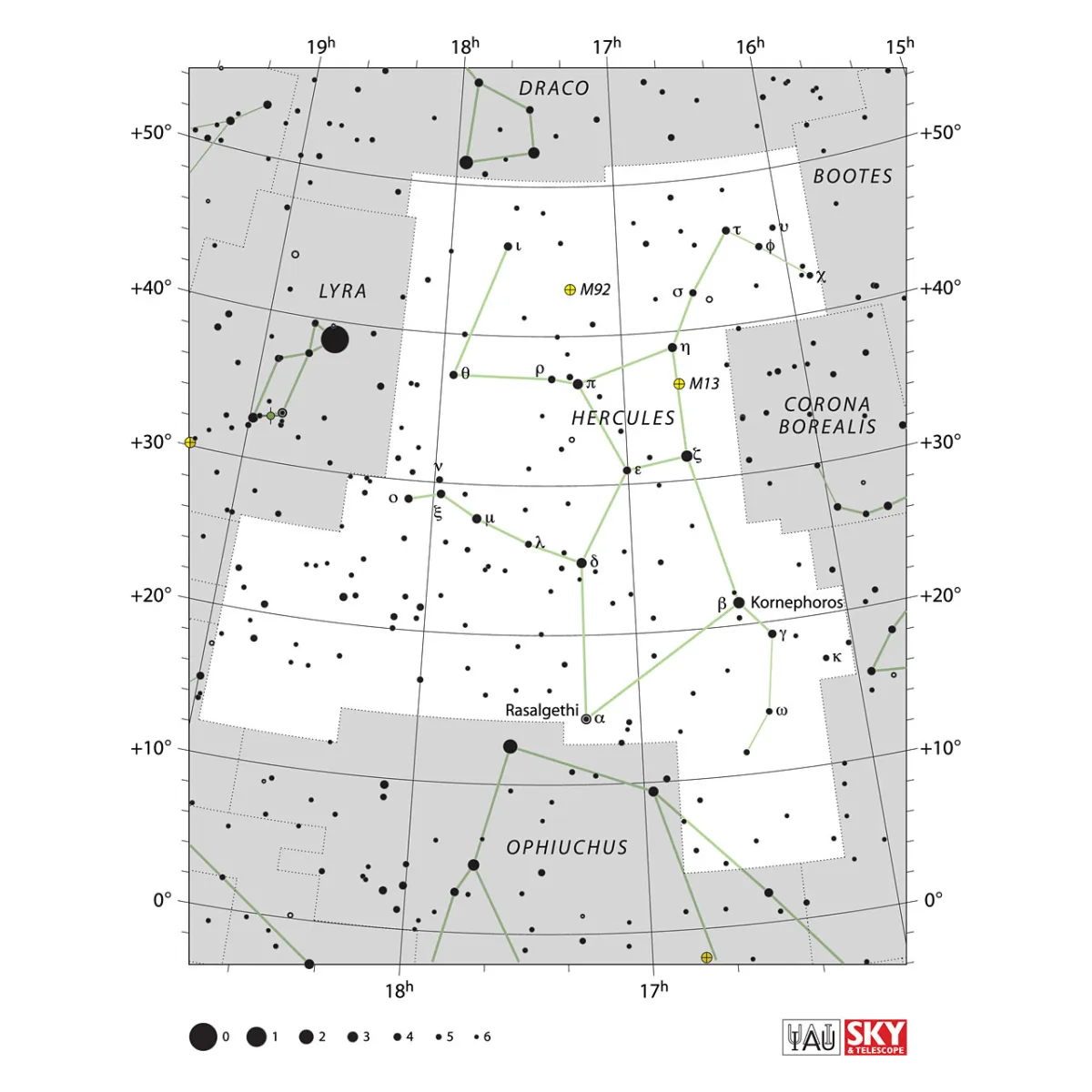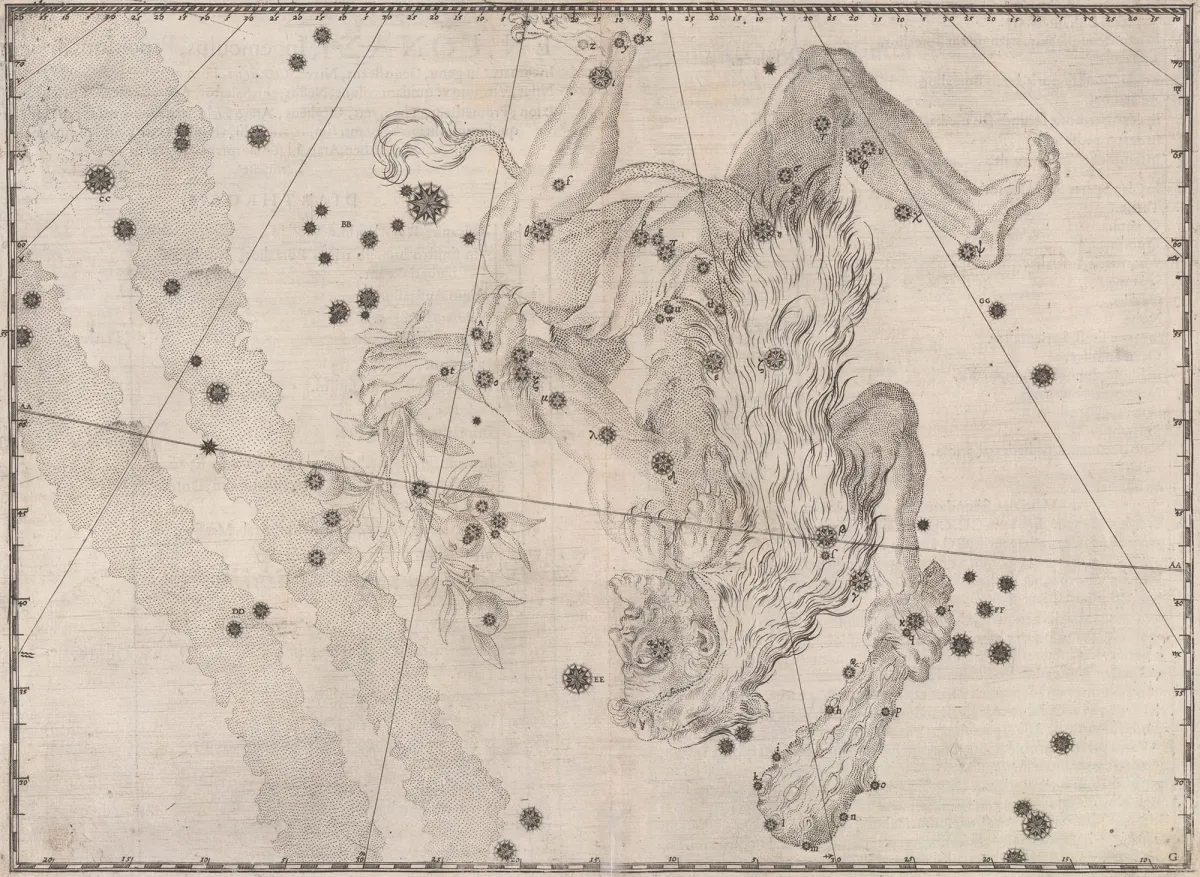Constellation Hercules

Properties
The constellation Hercules lies between Lyra and Corona Borealis, at the head of the dragon. Although it is the fifth largest constellation in the sky at 1225 square degrees, it is not that noticeable. The most striking thing about this constellation is the trapezoid in the middle at the height of the parallelogram of the lyre. From there it is easy to find the arms and legs of des Hercules. The centre of the constellation culminates around midnight on June 13th. [9, 15]
| α1 Her | Rasalgethi, Ras Algethi, Rasalegti |
| β Her | Kornephoros, Korneforos, Rutilicus |
| δ Her | Sarin |
| κ Her | Marfik, Marsik, Mirfak, Marfak |
| λ Her | Maasym, Masym, Misam |
| ω Her | Kajam, Cujam, Cajam, Caiam |
| IAU Name | Hercules |
| IAU Genitive | Herculis |
| IAU Abbr. | Her |
| English Name | Hercules |
| Culmination at local midnight | 12 June |
| Season (Latitude +0.0°) | February … November |
| Right Ascension (J2000.0) | 15h 48m 30s … 18h 57m 50s |
| Declination (J2000.0) | +03° 40' 25" … +51° 19' 27" |
| Area | 1225 deg2 |
| Neighbours (N↻) | Dra, Boo, CrB, Ser, Oph, Aql, Sge, Lyr |
Deep-Sky Object Descriptions
Catalogues
Mythology and History
Hercules, also Herakles (Heras fame) is probably the most famous figure of the Greek legend. Several constellations are therefore associated with it in the sky.

Alkmene was a granddaughter of Perseus, who only wanted to become the wife of Amphitryon when he returned from a war. In his absence, Zeus fell in love with the beautiful Alcmene. To spare her remorse, he appeared in the form of her husband Amphitryon. He even boasted in front of her of the heroic deeds that were actually taking place in another place at the same moment, and placed a golden goblet at her feet, which Amphitryon wanted to bring back as prey for his future wife. Is it any wonder that Alcmene gave himself to him? But as fate plays, the real Amphitryon also comes back to his Alcmene towards the morning of the same night after a successful battle. Zeus disappeared and Alkmene received her Amphitryon without knowing or even suspecting that she was loved and had sons by two different husbands on the same night: by Zeus Heracles and by the real Amphitryon Iphicles.
Zeus knew how to arrange it so that Hera took Heracles to her breast as an infant. He began to suckle with such force that it pushed him back and a stream of milk shot across the sky and became the Milky Way. But one sip of the divine milk was enough to make Heracles immortal.
Hera, the rightful wife of Zeus, was hated by this Heracles from the bottom of her soul and she understood - in a shrewd confusion of the succession - to deprive Heracles of the royal dignity due to him and to make Eurysteus king of Argos. Hence the dependence of Heracles on Erysteus, who imposed on him those well-known "twelve works" which were apparently impracticable, but which ultimately increased Heracles' fame immeasurably:
- Overcoming the Nemean Lion
- The battle with the Lernaean Hydra
- The capture of the Keryneian bitch
- Getting hold of the Erymanthian Bird
- The cleaning of the Augean stables
- The expulsion of the stymphalic birds
- Bringing the Cretan Bull
- The capture of the mares of Diomedes
- The robbery of the Amazon belt
- The kidnapping of Geryon's cattle
- The bringing in of the golden apples of the Hesperides
- The descent into the underworld
The Delphic Oracle commanded Heracles to build a pyre on Mount Oita and to climb it. The mighty fire burned everything that was mortal about Heracles and a lightning bolt was seen descending from the sky and Heracles was gone to the human eye. Zeus lifted him to Olympus and transformed it into a constellation.
A very early Phoenician name for this constellation is Melkarth. Melkarth or Melqart was the main god of Tire in Phenicia and was assigned to the sea and also to the shipping, which was very important there. There are pictures of this god on coins as he rides a sea horse. Melqart was later also considered the sun god and was equated with Heracles.
In addition to Hercules, one also reads Clavator and Claviger (club bearer), Alcides (Hercules as the grandson of Alceus), Amphitryoniades (Alkmene was the mother of Hercules and wife of Amphitryon), Heros Tirynthius (Tirynthian hero, Hercules) and Ramus pomifer (fruit-bearing branch, meaning the golden apples of the Hesperides).
This constellation was also interpreted as Ixion, whereby it comes in connection with the constellation of Sagittarius. Ixion was the king of Thessaly. He invited his future father-in-law Eioneus to the wedding, but he dug a pit at the gates of his palace, which he filled with glowing coals. Eioneus rushed in and died. This unprecedented crime was not forgiven for a long time until Zeus finally invited Ixion to the purification ceremony on Olympus, where Ixion tried to seduce Hera. Had Zeus not hastily created a cloud that looked like Hera, a second crime would have occurred. The cloud - it was Nephele - became pregnant and gave birth to the original centaur, a being half human and half horse, violent, maddened and unrestrained, who impregnated the wild mares from Pelion Mountain and begat the lineage of the Centaurs. Ixion was banished forever to the underworld, where he was tied to a fiery burning wheel that keeps turning. [20]
The constellation is also associated with the main character from the Sumerian Epic of Gilgamesh. Gilgamesh was the legendary demigod and ruler of Uruk, probably the oldest city in Babylonia. [7]
At this point it should be pointed out that the (no longer recognized) constellation Cerberus existed between Hercules and the Swan. [20]